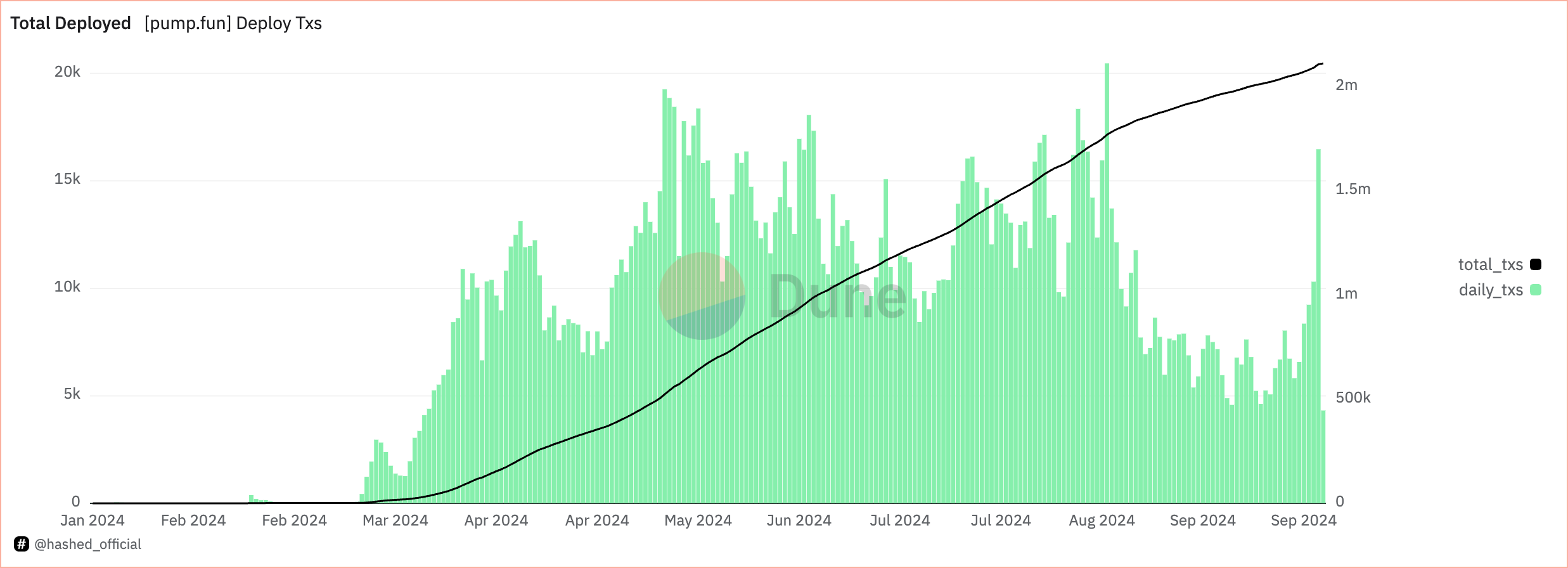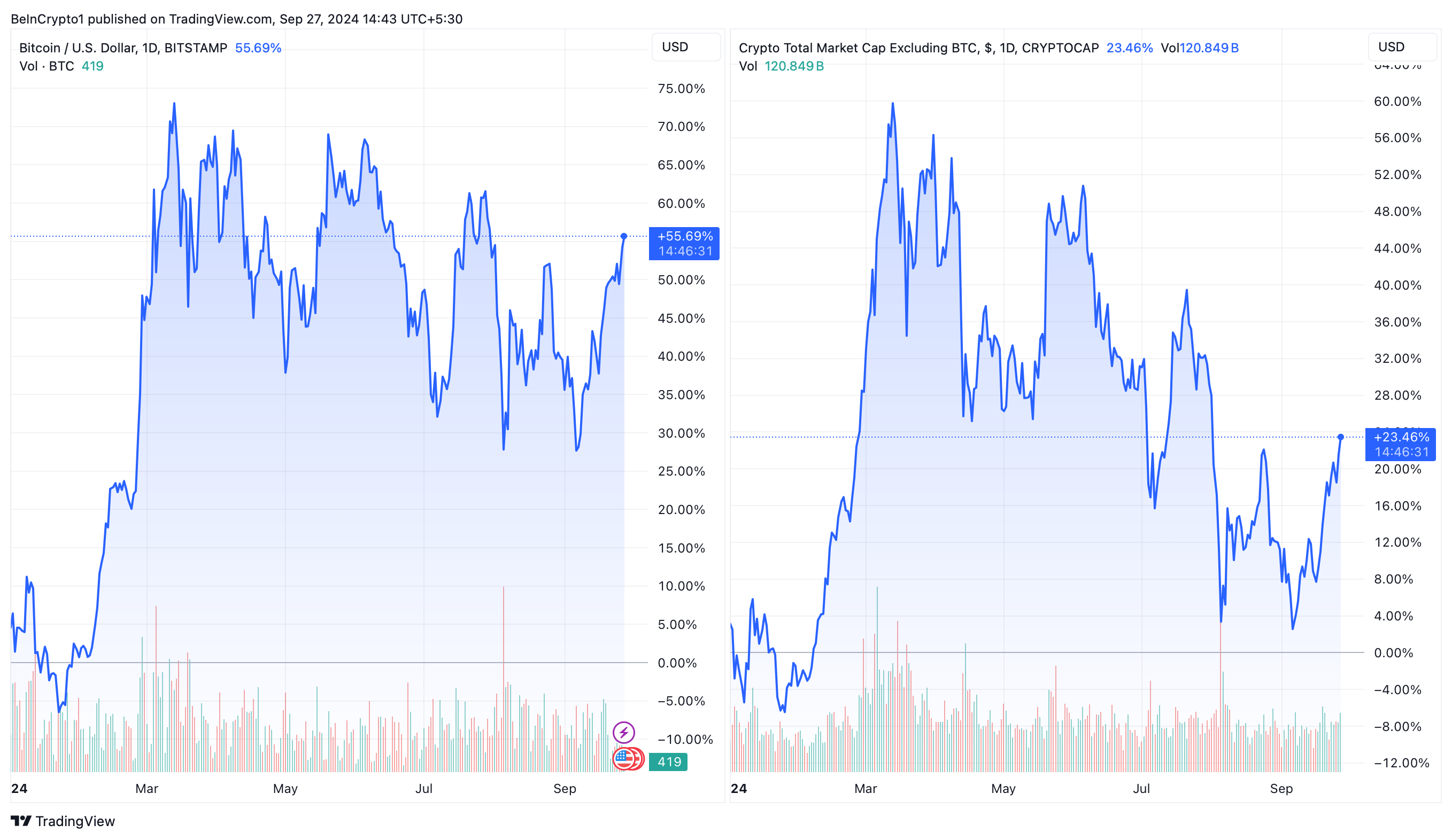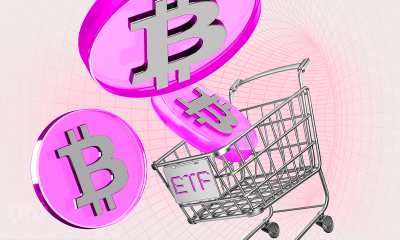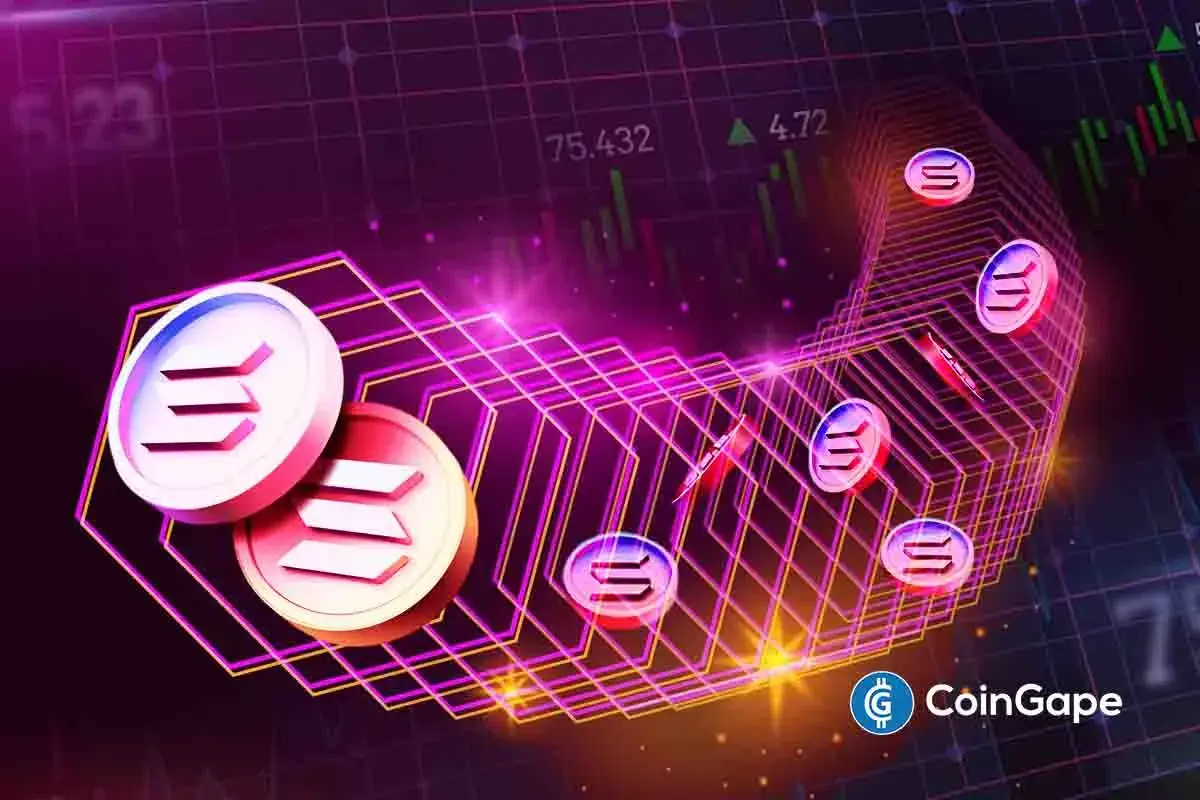Market
Binance Executive’s Top Strategies for 2024 Crypto Bull Market

In the crypto market, each bull cycle presents various challenges and opportunities. The 2024 bull cycle is shaping up to be a distinct departure from its predecessors, notably the 2017 and 2021 cycles.
This is because, in previous cycles, liquidity was concentrated in a handful of altcoins, simplifying investment choices for retail traders. However, the crypto market has evolved dramatically, with liquidity now spread across a rising number of altcoins.
Liquidity Fragmentation Due to Meme Coins
The crypto market’s expansion has been particularly marked by the proliferation of altcoins and meme coins, facilitated by platforms like Pump.fun. Since its inception in January 2024, the platform has been instrumental in the creation of over two million meme coins, amassing more than $138 million in fees.
Read more: 7 Hot Meme Coins and Altcoins that are Trending in 2024

The surge in such tokens has led to what Alex Odagiu, Investment Director at Binance Labs, refers to as “liquidity fragmentation.” In an interview with BeInCrypto, Odagiu highlighted the dual-edged nature of this trend.
“The surge of meme coins has undoubtedly created noise, but we see it as part of the natural evolution of the Web3 space. While it may cause short-term liquidity fragmentation, over time, the market will likely consolidate around projects with true value propositions,” he explained.
Despite their speculative nature, meme coins have played a pivotal role in attracting new users and fostering community engagement. Furthermore, Odagiu believes that as the market matures, investor focus will shift towards utility-driven projects that offer sustainable value and practical use cases.
Altcoin Investment Strategies
Since September 6, the price of Bitcoin has surged by nearly 25%. It is currently trading above $65,000, signaling a potential return of the bull market.
Yet, the overwhelming number of tokens has diluted the attention and hype that previously benefitted certain projects. Addressing this, Odagiu outlined strategies for long-term investors to navigate the crowded market effectively.
“In a market flooded with new tokens, it’s crucial for investors to focus on fundamentals rather than chasing hype. Long-term investors should take a disciplined approach when differentiating between short-term trends and long-term value. Projects with real-world use cases, strong teams, solid roadmaps, and sustainable business models are more likely to survive multiple market cycles,” Odagiu stressed.
Read more: 11 Cryptos To Add To Your Portfolio Before Altcoin Season
He also revealed that despite the apparent saturation, substantial potential remains within specific sectors such as decentralized finance (DeFi), infrastructure, real-world asset tokenization, and applications that aim to achieve mass adoption.
“Projects that prioritize strong technological innovation, demonstrate meaningful product-market fit, and have sustainable revenue models will continue to attract interest despite the crowded market,” Odagiu stated.
Odagiu advised a balanced approach to building a strong crypto portfolio. He believes that a solid crypto portfolio should be diversified across different asset types and sectors.
“Bitcoin remains a foundational asset due to its stability and market dominance, but altcoins that drive real technological innovation and have strong community support can present substantial growth opportunities. Diversification across sectors—such as DeFi, infrastructure, and gaming—can also help mitigate risk while capturing opportunities in emerging trends,” he elaborated.
Bitcoin Continues to Remain Institution’s Favorite Crypto
Amid Bitcoin’s dominant market position, institutional focus remains largely trained on it, often at the expense of other promising altcoins. Year-to-date, Bitcoin’s price has increased by over 55%, while the total crypto market cap, excluding Bitcoin, has risen by just 23%.
Read more: Who Owns the Most Bitcoin in 2024?

Moreover, according to crypto analyst Murad Mahmudov, only 42 tokens among the top 300 on CoinMarketCap have outperformed Bitcoin so far in 2024. Odagiu explains why Bitcoin remained a dominant crypto in the 2024 bull cycle.
“Bitcoin’s dominant position in the market is deeply rooted in its status as the first cryptocurrency, which institutional investors often view as a simpler, more familiar, and less risky asset compared to Ethereum and altcoins. Bitcoin’s narrative as a store of value, often referred to as ‘digital gold,’ aligns with traditional investment strategies, making it a natural entry point for institutions new to the crypto space,” Odagiu explained.
However, as institutional investors gain familiarity with the crypto ecosystem, Odagiu anticipates increased interest in Ethereum (ETH) and other altcoins.
“With that said, we (Binance Labs) expect interest in Ethereum and other altcoins to grow as institutions continue to gain confidence in the broader Web3 ecosystem and see the utility beyond Bitcoin,” he added.
The current market cycle also highlights the rise of leveraged trading among crypto traders. Data from Coinglass indicates that open interest stands at $35.93 billion, near its four-year high.
Open interest refers to the total number of outstanding derivative contracts, like futures and options, that have not been settled. It’s used as an indicator to gauge market sentiment.
Read more: How To Trade Crypto on Binance Futures: Everything You Need To Know

However, Odagiu cautioned against the lure of high-risk leverage. He stated that leverage can amplify both gains and losses, so it’s important for investors to use it responsibly, especially in volatile markets.
“Ultimately, long-term success in crypto comes from sound investment principles rather than chasing short-term gains with high-risk leverage,” he concluded.
Indeed, the crypto market demands that investors adapt by prioritizing sustainable investment strategies, enabling them to navigate the challenges of the 2024 bull cycle with informed confidence.
Disclaimer
Following the Trust Project guidelines, this feature article presents opinions and perspectives from industry experts or individuals. BeInCrypto is dedicated to transparent reporting, but the views expressed in this article do not necessarily reflect those of BeInCrypto or its staff. Readers should verify information independently and consult with a professional before making decisions based on this content. Please note that our Terms and Conditions, Privacy Policy, and Disclaimers have been updated.
Market
Report Alleges Massive Meme Coin Sniping on Pump.fun

According to a new report from Pine Analytics, token deployers on Pump.fun systematically funded sniper wallets to buy their own meme coins. This impacted over 15,000 token launches on the platform.
These sniper wallets operated primarily during US trading hours, executing standardized, profitable strategies. Unrelated bot activity obscures their behavior, making it extremely difficult to isolate these wallets—and they can readily adapt to new countermeasures.
Snipers Roam Free on Pump.fun Meme Coins
Pump.fun has remained one of the most popular meme coin launchpads on Solana despite persistent controversies and other criticism.
However, Pine Analytics’ new report has uncovered a new controversy, discovering systematic market manipulation on the platform. These snipes include as much as 1.75% of all launch activity on Pump.fun.
“Our analysis reveals that this tactic is not rare or fringe — over the past month alone, more than 15,000 SOL in realized profit was extracted through this method, across 15,000+ launches involving 4,600+ sniper wallets and 10,400+ deployers. These wallets demonstrate unusually high success rates (87% of snipes were profitable), clean exits, and structured operational patterns,” it claimed.
Solana meme coin deployers on Pump.fun follow a consistent pattern. They fund one or more sniper wallets and grant them advance notice of upcoming token launches.
Those wallets purchase tokens in the very first block and then liquidate almost immediately—85% within five minutes and 90% in just one or two swap events.

Pump.fun meme coin developers exploit this tactic to create the appearance of immediate demand for their tokens. Retail investors, unaware of the prior sell‑off, often purchase these tokens after the snipe, giving developers an unfair advantage. This constitutes market manipulation and erodes trust in the platform.
Pine Analytics had to carefully calibrate its methods to identify genuine snipers. Apparently, 50% of meme coin launches on Pump.fun involve sniping, but most of this is probably bots using the “spray and pray” method.
However, by filtering out snipers with no direct links to developer wallets, the firm missed projects that covered their tracks through proxies and burners.
In other words, the meme coin community does not have adequate defenses against systematic abuse on Pump.fun. There are a few possible ways that the platform could flag repeat offenders and sketchy projects, but adaptive countermeasures could defeat them. This problem demands persistent and proactive action.
Unfortunately, it may be difficult to enact such policies. Meme coin sniping is so systematic that Pump.fun could only fight it with real commitment.
Analysts think that building an on-chain culture that rewards transparency over extraction is the best long-term solution. A shift like that would be truly seismic, and the meme coin sector might not survive it.
Disclaimer
In adherence to the Trust Project guidelines, BeInCrypto is committed to unbiased, transparent reporting. This news article aims to provide accurate, timely information. However, readers are advised to verify facts independently and consult with a professional before making any decisions based on this content. Please note that our Terms and Conditions, Privacy Policy, and Disclaimers have been updated.
Market
Solana Leads Blockchain Metrics as SOL Momentum Builds

Solana (SOL) continues to show strength across multiple fronts, maintaining a bullish structure on its Ichimoku Cloud chart while gaining momentum in key market metrics. The BBTrend indicator has turned higher again, signaling renewed buying pressure after a brief cooldown.
On-chain activity remains strong, with Solana leading all blockchains in DEX volume and dominating fee generation thanks to the explosive growth of meme coins and launchpad activity. With SOL now trading above a key resistance level, the path is open for further upside—though a loss of momentum could still trigger a retest of lower supports.
Solana Maintains Bullish Structure, but Momentum Faces Key Test
On Solana’s Ichimoku Cloud chart, the price is currently above the Kijun-sen (red base line) but has dipped below the Tenkan-sen (blue conversion line), signaling weakening short-term momentum.
The flattening Tenkan-sen and price behavior suggest possible consolidation or the early stages of a pullback. Still, with the price holding above the Kijun-sen, medium-term support remains intact.

The overall Ichimoku structure remains bullish, with a thick, rising cloud and leading span A well above span B—indicating strong underlying support.
If Solana finds support at the Kijun-sen and climbs back above the Tenkan-sen, the uptrend could regain strength; otherwise, a test of the cloud’s upper boundary may follow.

Meanwhile, Solana’s BBTrend is currently at 6, extending nearly ten days in positive territory after peaking at 17.5 on April 14. The recent increase from 4.26 to 6 suggests renewed bullish momentum following a brief cooldown.
BBTrend, or Bollinger Band Trend, tracks the strength of price movement based on Bollinger Band expansion.
Positive values like the current one point to an active uptrend, and if the BBTrend continues to rise, it could signal stronger momentum and potential for another upward move.
Solana Dominates DEX Volume and Fee Generation as Meme Coins Drive Ecosystem Growth
Solana has once again claimed the top spot among all chains in DEX volume, recording $15.15 billion over the past seven days. The combined total of Ethereum, BNB, Base, and Arbitrum reached $22.7 billion.

In the last 24 hours alone, Solana saw $1.67 billion in volume, largely fueled by its booming meme coin ecosystem and the ongoing launchpad battle between PumpFun and Raydium. Adding to this good momentum, Solana recently surpassed Ethereum in Staking Market Cap.

When it comes to application fees, Solana’s momentum is just as clear. Four of the top ten fee-generating apps over the past week—PumpFun, Jupiter, Jito, and Meteora—are Solana-focused.
Pump leads the pack with nearly $18 million in fees alone.
Solana Breaks Key Resistance as Uptrend Targets Higher Levels, but Risks Remain
Solana has finally broken above its key resistance at $136, flipping it into a new support level that was successfully tested just yesterday.
Its EMA lines remain aligned in a bullish setup, suggesting the uptrend is still intact.
If this momentum continues, SOL price could aim for the next resistance zones at $147 and $152—levels that, if breached, open the door to a potential move toward $179.

The current structure favors buyers, with higher lows and strong support reinforcing the trend.
However, if momentum fades, a retest of the $136 support is likely.
A breakdown below that level could shift sentiment, exposing Solana to deeper pullbacks toward $124 and even $112.
Disclaimer
In line with the Trust Project guidelines, this price analysis article is for informational purposes only and should not be considered financial or investment advice. BeInCrypto is committed to accurate, unbiased reporting, but market conditions are subject to change without notice. Always conduct your own research and consult with a professional before making any financial decisions. Please note that our Terms and Conditions, Privacy Policy, and Disclaimers have been updated.
Market
Crypto Firms Donated $85 million in Trump’s Inauguration

According to a new report, 15 firms and individuals from the crypto industry donated more than $100,000 to President Trump’s Inauguration, totaling over $85 million.
Almost all of these companies apparently received direct or indirect benefits from Trump’s administration. This includes dropped legal proceedings, lucrative business partnerships, participation in Trump’s Crypto Summit, and more.
Crypto Industry Went All-In on Trump’s Inauguration
Since promising to bring friendlier regulations on the campaign trail, Donald Trump attracted a reputation as the Crypto President.
Trump’s Inauguration festivities included a “Crypto Ball,” and several prominent firms made donations for these events. Today, a report has compiled all crypto-related contributions of over $100,000, revealing some interesting facts.

Since taking office, President Trump and his family have been allegedly involved in prominent crypto controversies, and these donations may be linked to several of them.
For example, eight of the donors, Coinbase, Crypto.com, Uniswap, Yuga Labs, Kraken, Ripple, Robinhood, and Consensys, had SEC investigations or lawsuits against them closed since Trump’s term began.
The commission might have dropped its probe against these companies anyway due to its changing stance on crypto enforcement. However, being in the President’s good books likely helped the process.
Further Alleged Benefits for Donors
In other words, nearly half the firms that made donations to Trump’s Inauguration have seen their legal problems cleared up quickly. This isn’t the only regulation-related benefit they allegedly received.
Circle, for example, recently made an IPO after openly stating that Trump’s Presidency made it possible. Galaxy Digital received SEC approval for a major reorganization, a key step for a NASDAQ listing.
Other donors, such as Crypto.com and ONDO, got more direct financial partnerships with businesses associated with the Trump family.
Previously, Ripple’s CEO, Brad Garlinghouse, anticipated a crypto bull market under Trump. Also, XRP, Solana, and Cardano were all unexpectedly included in the US Crypto Reserve announcement.
All three of these companies made major donations to Trump’s Inauguration.
It seems that most of the firms involved got at least some sort of noticeable benefit from these donations. Donors like Multicoin and Paradigm received invitations to Trump’s Crypto Summit, while much more prominent groups like the Ethereum Foundation got snubbed.
Meanwhile, various industry KOLs and community members have already alleged major corruption in Trump’s crypto connections.
While some allegations might lack substantial proof, the crypto space has changed dramatically under the new administration, for both good and bad.
Disclaimer
In adherence to the Trust Project guidelines, BeInCrypto is committed to unbiased, transparent reporting. This news article aims to provide accurate, timely information. However, readers are advised to verify facts independently and consult with a professional before making any decisions based on this content. Please note that our Terms and Conditions, Privacy Policy, and Disclaimers have been updated.
-

 Market24 hours ago
Market24 hours agoCoinbase Lists RSR, Atkins Association Fuels Bullishness
-

 Altcoin24 hours ago
Altcoin24 hours agoAnalyst Reveals How High XRP Price Can Go If This Happens
-

 Altcoin23 hours ago
Altcoin23 hours agoArk Invest Gains First Exposure to Solana With 3iQ ETF Bet
-

 Market23 hours ago
Market23 hours agoBitcoin ETFs Dominate Market Despite 72 Altcoin Proposals
-

 Market22 hours ago
Market22 hours agoCardano (ADA) Jumps 4% as Bullish Signals Emerge
-

 Altcoin22 hours ago
Altcoin22 hours agoPumpFun Moves $13M SOL To Kraken as Solana Price Consolidates, What Next?
-

 Ethereum20 hours ago
Ethereum20 hours agoEthereum to Emphasize Layer-1 Efficiency and UX in Upcoming Protocol Upgrades
-

 Market21 hours ago
Market21 hours agoXRP Surpasses Ethereum In This Major Metric After Outperforming For 6 Months

















